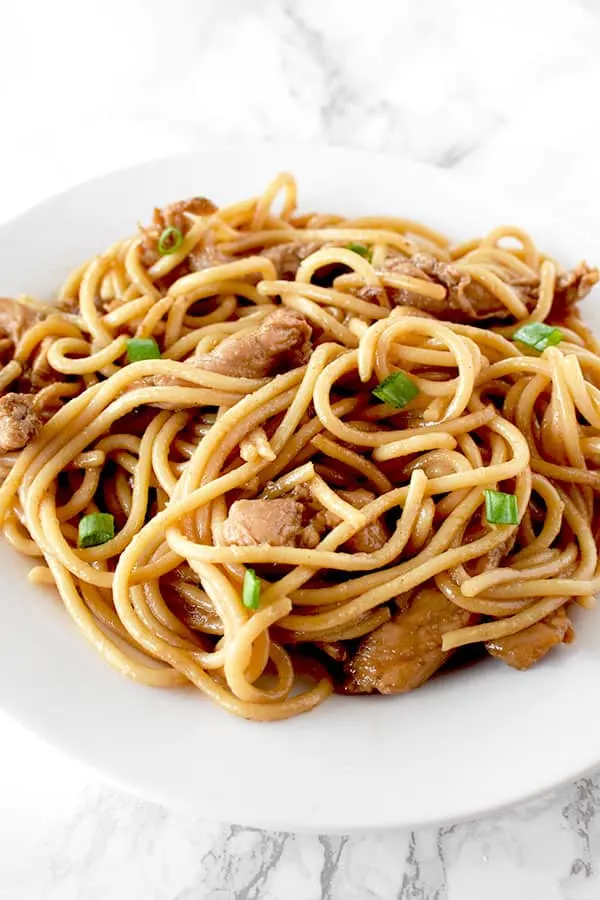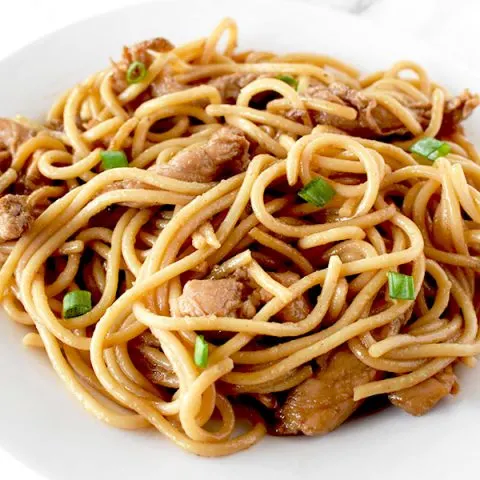Chicken Lo Mein is surprisingly easy to make at home. In fact, it's so simple, you can even make it on a weeknight.

Chicken Lo Mein is the less popular, but still delicious younger brother to Beef Lo Mein.
Not unlike Chicken and Broccoli, it was probably created as a chicken alternative to a beef dish.
Still, it is just as delicious as other more popular chicken dishes like sesame chicken and orange chicken.
HOW TO REPLACE LO MEIN NOODLES
If you don’t have lo mein noodles, you can easily use spaghetti instead.
The main difference between lo mein noodles and spaghetti noodles is that lo mein noodles are egg noodles.
However, you really won’t taste much of a difference under flavorful sauce.
What is the difference between lo mein and chow mein?
Lo mein uses soft, fully-cooked noodles that are stirred into the dish, while chow mein uses crispy, fried noodles.
What is the difference between lo mein and udon?
Lo mein uses egg noodles, whereas udon is made with wheat noodles, usually wider. The eggs in lo mein noodles also gives them a chewier texture compared to udon.
DARK MEAT VS WHITE MEAT
Most people have a preference between eating white meat or dark meat. They both certainly have their benefits and detriments in this recipe.
White meat has the benefit of being lean, more readily available as boneless and skinless, and it cooks quickly.
Dark meat is juicer and does not dry out as quickly, making it a safer choice.
At the end of the day, you can use either white or dark meat for this recipe. The choice is yours. I often just choose based on what I have on hand.
IS KOSHER CHICKEN BETTER?
Kosher animals are kept in better conditions than non-kosher animals due to strict kosher health requirements of the animals.
Also, the salting process used as part of the process of making meat kosher is similar to dry brining, and therefore produces a better quality meat.
While I’ve only eaten kosher meat so I cannot compare, I’ve been told by non-Jews who do not keep kosher that they’ve noticed that kosher chicken is of superior quality to cook with.
SHOULD YOU WASH CHICKEN?
According to the USDA, you should not wash meat or poultry, since water can splash bacteria up to 3 feet surrounding your sink.
A study done by Drexel University shows that it is best to move meat and poultry directly from package to pan. The heat from cooking will get rid of any bacteria that may be present.
HOW CAN I CLEAN MY CHICKEN WITHOUT WASHING IT?
If you want to clean your chicken without washing it, wipe it down with a wet paper towel.
Just make sure the paper towel doesn't touch anything else and to toss the paper towel right away.
HOW TO DEFROST CHICKEN
IN THE FRIDGE
Defrosting chicken in the fridge is the most highly recommended.
To do this, place the frozen chicken in a pan and let it thaw. Oftentimes, when chicken thaws, it releases liquids that can leak onto your fridge, so the pan is really helpful.
Chicken typically takes a full day to thaw. Once thawed, it can remain in the refrigerator for a day or two before cooking.
IN COLD WATER
Defrosting chicken in water should take two to three hours.
Submerge your sealed chicken in a pot or bowl full of cold water. Change out the water every 30 minutes or so.
Do not hot use water because it can start cooking your chicken.
Can you cook FROZEN chicken?
According to the USDA, you can cook frozen chicken. It will take 50% longer to cook, but it’s an option.
You should also cook it on a roasting rack or over vegetables so that the heat can circulate around the chicken.
CAN YOU REFREEZE RAW CHICKEN?
According to the USDA, “food thawed in the refrigerator is safe to refreeze without cooking.” However, you do lose quality when refreezing previously defrosted meat.
Every time you defrost meat, it loses moisture as it thaws, which also leads to a loss in flavor. To compensate for this, marinate the chicken to add more flavor and juice.
The USDA also says not to “refreeze any foods left outside the refrigerator longer than 2 hours; 1 hour in temperatures above 90°F.”
SHOULD YOU BRINE?
Brining actually doesn’t do anything to help poultry. In fact, it makes it soggy rather than juicy, with watered-down flavor.
Aromatic brines and stock don’t help with flavor either. This is because the salt pulls water molecules in, leaving most of the flavor behind.
DRY BRINING
A dry brine, on the other hand, loosens up muscle fibers, allowing them to retain more moisture without adding any excess liquid.
Initially, the salt draws moisture out, then it dissolves in this liquid, creating a concentrated brine, which eventually gets reabsorbed. This leads to more intensely flavored results.
An added benefit is that it also requires less space and mess than a water brine. Not to mention the fact that it allows for crispier skin.
CAN YOU DRY BRINE KOSHER chicken?
Food experts are often under the impression that kosher meat and poultry cannot be brined and dry brined.
This is because of the koshering process, which involves salting the meat. However, the process is not nearly as long as the dry brining process, and unlike a dry brine, the poultry is soaked to remove the salt.
So, since the process is different than a dry brine, it is fine and even recommended to dry brine kosher poultry and meat.
How do you dry brine chicken?
Begin by patting the chicken with paper towels. This will help the salt adhere to the chicken.
Grab pinches of kosher salt and sprinkle it over the chicken until the chicken is generously salted and evenly coated.
Place the dry-brined chicken on a rack or a plate and refrigerate it. Refrigerate chicken pieces for at least 1 hour, skinless pieces for 30 minutes to 1 hour or up to about 12 hours, and a whole chicken for 8-24 hours.
Once the waiting period is up, there is no need to rinse off the chicken. Just cook it as usual.
HOW TO STORE CHICKEN
Place cooled chicken in an airtight container or wrap in heavy-duty aluminum foil or plastic wrap. Store in the fridge for up to 4 days.
HOW TO FREEZE CHICKEN
Freeze leftovers within 3-4 days. Place cooled chicken in an airtight container or resealable freezer bag.
Freeze for up to 4-6 months. After that, it is still safe to eat, but the quality begins to degrade.
Kosher Chicken Lo Mein

Chicken Lo Mein is a classic American-Chinese dish, and this recipe makes it easy to make at home.
Ingredients
- 8 oz lo mein or spaghetti noodles
- 1 pound chicken, sliced into thin strips
- 2 garlic cloves, minced
- 1 cup bean sprouts
sauce
- ¼ cup beef stock
- 3 tablespoon soy sauce
- 2 tablespoon brown sugar
- 1 teaspoon sesame oil
Instructions
- Cook the noodles as directed on the box.
- Saute the chicken. When the beef is mostly cooked, add the garlic and saute lightly.
- Add the noodles to the beef in the saute pan.
- Combine beef stock, soy sauce, brown sugar, and sesame oil in a bowl.
- Pour the mixture over the noodles. Stir-fry for 30 seconds.
- Add the bean sprouts. Stir-fry for one more minute and serve.
Nutrition Information:
Yield:
6Serving Size:
1Amount Per Serving: Calories: 279Total Fat: 12gSaturated Fat: 3gTrans Fat: 0gUnsaturated Fat: 8gCholesterol: 71mgSodium: 680mgCarbohydrates: 20gFiber: 1gSugar: 5gProtein: 22g